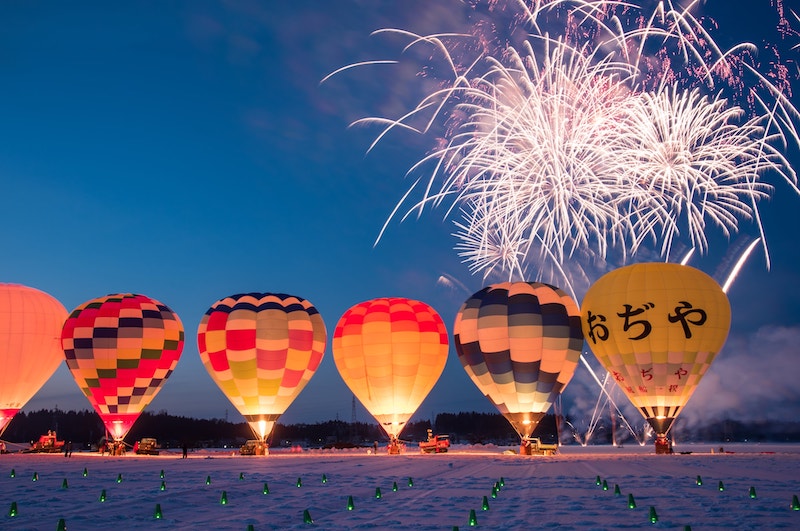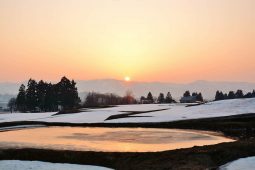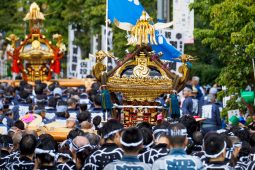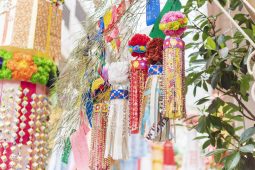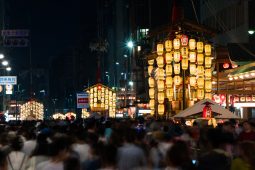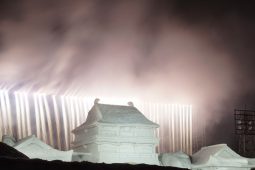At some point, Ojiya decided that just the year-round attractions don’t make it interesting enough. This is very lucky for us, because that means it has a lot of seasonal events for us to go through as well.
Firstly, you have the bullfighting. I know you’re probably thinking of a man jumping about throwing spears or something at a single bull, and I promise you, I don’t like that either. I was very skeptical when I first heard about ’bullfights’, but it turned out to be a bit different from what I expected: The actual bulls ’fight’ (it’s mostly bashing their horns together — covered so they can’t hurt each other — and roaring at each other a lot) for a bit, go home and collect a big meal; as far as I can tell, they very much enjoy the whole thing as long as it’s just once in a while… which isn’t a huge surprise from animals that will charge after the nearest person if you catch them in the wrong mood. Nobody gets hurt, or else I wouldn’t be talking about this. They’re meant to fight to a draw, and the handlers go in to break up the fight (which is part of the show itself, really).
Theoretically, the city thinks of this as a ‘spring‘ event. Considering it happens ’every month from May to November’, I’m just going to say that living in the north gives people very interesting ideas about the seasons.
Summer is camping and festival season. Here, I’ve saved myself a lot of time by writing about festivals in Japan before.It’s a few of those, and really good ones.It’s summer in Japan, every place from big cities to tiny little villages is going to have several wild festivals and nothing in the world can stop that. I recommend it, though. Certainly, if you happen to go there during summer, you’ll want to aim for the Ojiya Matsuri, which is usually towards the end of august; apart from the usual, they have about 7,000 fireworks on average, lots of floats, bull parades, masked dance performances and so on over the course of three days.
As a sort of continuation of that, you have the Katakai Festival in autumn.It’s early September, though (8 ~10 next year, if you want to be there), so I always think of it as summer. I mentioned living in the north makes you wrong about seasons, right? Anyway, Katakai is a bit unusual among festivals in that it knows it’s all about the fireworks and almost the entire festival is about that. They’re right, though.It’s an impressive display in its own right, but the star of the show is the yon shaku dama, the single biggest firework in the entire world.It needs its own special, oversized steel launcher, it weighs 420 kg (or 925 pounds, if you prefer), and the explosion is 800 m across (or again, half a mile if that suits you better). Katakai was also the first to pioneer the somewhat smaller san shaku dama back in 1891, proving that they have always loved making enormous explosions. Good for them.
I remembered winter, when I started writing this, as the quiet season where nothing much happens. Everything else about Ojiya just blocked it out in my head. Luckily, I am very, very wrong. Winter (specifically Feb 22 ~23 next year) is the hot air balloon festival, which I somehow forgot about. The event is held on a huge snowy field (not hard to find in this part of the country, let’s be honest), with dozens of hot air balloons sitting on the snow, with a festival all around them.It’s your usual festival — stalls, fireworks, etc.— but on snow, and with the addition of… the balloons. What do they do? Well, for one, you really need to see them sitting there lit up in rows at night. Trust me. They look almost as impressive taking off in a huge fleet at the end of the festival, but seeing rows of giant balloons just sitting there and glowing on the snow is a very special sight.
If you drink at all (I don’t), I’ve heard a lot of talk about Ojiya’s sake in this season as well; I can’t vouch for how it tastes, for obvious reasons, but the idea of leaving it to mature under meters of snow for the entire winter was interesting enough to me that I did go to see how it’s made. In general, though, yes: The draw of Ojiya’s winter is the snow, the balloon festival, and as usual, the city itself.It never really stops being a lovely place.
I’ve had to cut an awful lot, and I don’t even mean the part where I had to abbreviate to ’sure, they have a couple dozen national heritage sites if you like’, but Ojiya really has an incredible amount to offer. Even leaving out the seasonal events, it probably calls for a few visits if you can do that. There aren’t many places I can recommend higher that I don’t already live in, though, so I’ll just say this:
Go to Ojiya some time, when you can. I really, honestly can’t imagine anyone being disappointed by it. With so much there, you’re bound to find something that’s perfect for you. You’ll probably keep coming back to the carp and the Katakai festival, though, if you’re anything like me.
Lastly, here are the sites I mentioned, which are very nice for finding out what happens when, where to go, and so on. Like I said, the first doesn’t do English very helpfully, and the second doesn’t do it at all; this is mostly just a resource if you know your Japanese already. The second site has some videos, though.
According to the site, it takes about two and a half hours by motorway to get to Ojiya from most parts of Tokyo, or two hours by the Joetsu Shinkansen bullet train. Knowing Tokyo traffic, I would probably add a few hours to the car estimate, just in case.
https://www.city.ojiya.niigata.jp/site/kanko/ (Primary tourism site)
http://www.ojiyakanko.com/ (Secondary site)


